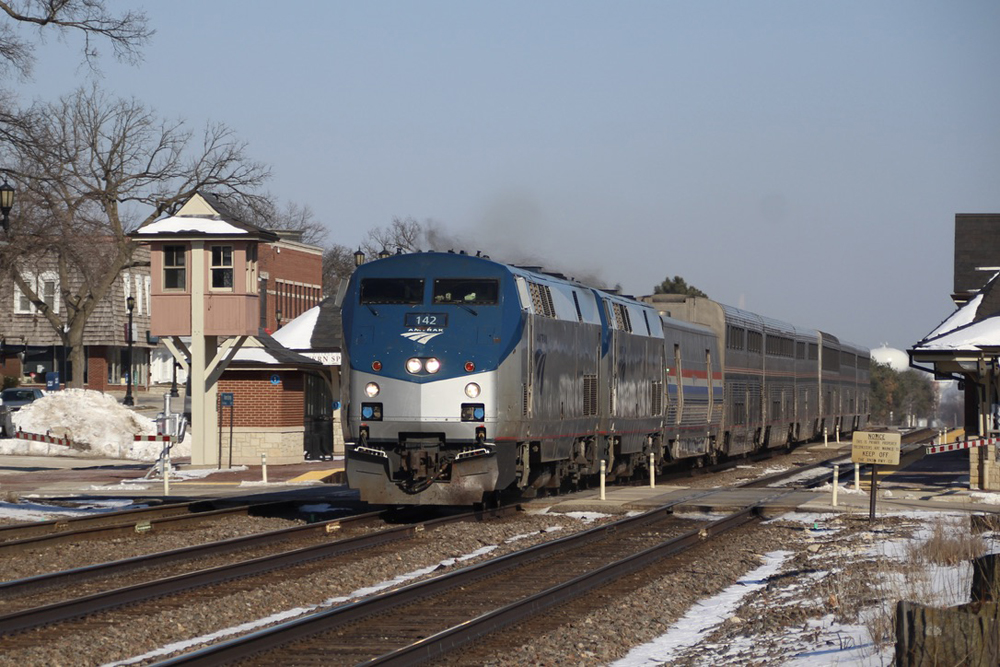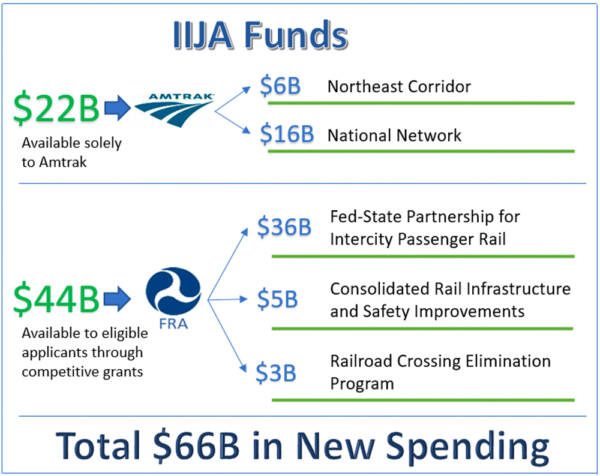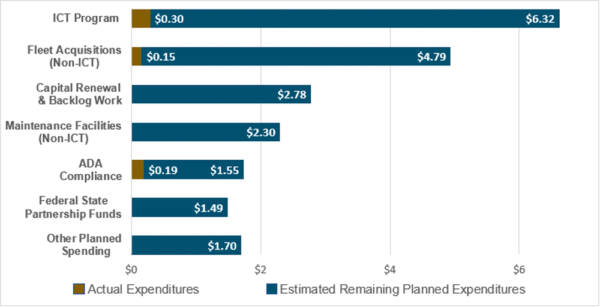
WASHINGTON — Amtrak’s Office of Inspector General on Wednesday released a report detailing the steps the company says it is taking to use, account for, and report on the $22 billion it is slated to receive directly from Infrastructure Investment and Jobs Act (IIJA) funding [see “Infrastructure bill addresses Amtrak priorities, congressional requirements,” News Wire, Nov. 8, 2021].

The 2021 legislation also provides an additional $44 billion to fund competitive grant opportunities, such as the Federal-State Partnership Program for Intercity Passenger Rail, in which Amtrak is partnering with states and operating authorities to expand service. A total of $1.49 billion has been allocated for matches here.
The IG report largely covers investments over which Amtrak has complete control, including:
- $6.62 billion for Siemens Aero trainsets and the substantial modification of facilities everywhere they will require servicing.
- $4.94 billion to replace the long-distance fleet and locomotives
- $2.78 billion to address deferred capital projects and reduce inventory of obsolete assets
- $2.38 billion to upgrade or modify maintenance facilities
- $1.74 billion for Americans With Disabilities Act requirements as specific stations
Some detail is provided in Appendix C of the full report.
For example, there are 33 line items associated with acquisition of the Aero trainsets, but which “obsolete assets” are to be reduced is not stated. The Appendix notes if Amtrak has submitted a cost estimate for each category and whether the Federal Railroad Administration has approved the expenditure. However, the actual amounts are redacted “due to [their] sensitive nature.”
In general, the Inspector General’s report is supportive of the restructuring Amtrak management has “proactively taken” to administer perhaps the biggest injection of federal funds at any single point in the company’s history. Considerable corporate resources are being allocated to fulfill the IIJA’s reporting requirements, including creation of an implementation committee and project tracker. About $700 million has been spent so far.

The OIG report concludes, “It is too soon to assess the effectiveness” of plans and “processes” Amtrak is implementing. “Accordingly, we are not making recommendations in this report, but we have initiated audits of individual IIJA-funded programs to assess the company’s management and use of its IIJA funds.”














What is the point of struggling to make such assessments when the real issues continue to percolate to the detriment of a viable Amtrak: a naive corporate management team making decisions on the fly, unchecked; a Board of Directors lacking in numbers and requisite experience.
Debating single level or bi-level is irrelevant if such equipment sits in the yards awaiting skilled maintenance that no longer exists.
As the nation’s unacceptable deficit continues to grow, who doesn’t think that CEO Gardner’s unacceptable leadership has left the barn door open for the financially tuned-in House to sacrifice in the name of cutting costs?
Some of this cash infusion needs to be applied to present day, in service rolling stock, and for equipment awaiting repair and upgrading for long distance trains. Monitoring long distance train movements, it is almost an everyday occurrence that trains are unable to meet departure schedules due to “Mechanical Issues”. Also, not uncommon, is equipment breakdowns while in route. Seems like a vigorous recurring maintenance program is extremely important while the traveling public await the arrival of new equipment.
Single level equipment on western LD routes would limit capacity unless they added longer consists but that would require additional staffing. Currently a Superliner slpr has four restrooms/dressing rooms downstairs plus 4 roomettes & family/handicap suite. If you put four restrooms plus a shower in a single level car it would drastically cut into your room capacity. Single level may work for short overnight routes in the east & south route but would drastically impact capacity & ticket price on western LD routes.
Quote ” $2.78 billion to address deferred capital projects and reduce inventory of obsolete assets” unquote. That is a troubling number. Does it mean fixing up passenger equipment so it can be sold instead of keep it for surge fleet equipment?
The LIRR did NOT close off the lead MU cars. I commuted on it for over five years.
However you are correct in that most long distance had the RPO and bags behind the engine.
Years ago baggage cars were positioned behind the locomotive and the same went for express cars or lcl cars. It acted as a natural buffer between the locomotive and the first passenger car on a train. Also I remember some commuter railroads including the LIRR in New York where the first car was closed off to all passengers as a safety measure in the event of a collision or derailment. Amtrak is doing the opposite of this practice by sticking the baggage carr on the rearof the train. Also for greater flexibility and operational practices, going forward only single level passenger cars should be manufactured and used in service and create a car that can be used all over the national network whether on the West Coast or Midwest or East Coast. This operational flexibility can help to alleivate any car shortages or when cars need to be added or taken off on any train on any given day or trip as traffic allows. The airlines learned that lesson by replacing their big jumbo jet fleets with more cost effective flexible aircraft that can be used anywhere in the country on any of their routes as service and customer demand dictates. Even in New York City, the MTA is realizing the folly of using longer subway cars that are 75feet long and cant be used on certain lines creating an operating and logistical nighmare as to using shorter subway cars that can operate on any line of the system. Of course the only difference is the shorter distance and clearance of the IRT and combined IND/BMT system. But a shorter subway car that can least operate over all lines of the BMT and INd otherwise known as the Dvison 2 lines. Shorter and more versatile is better and more flexible
Joseph C. Markfelder
First, I don’t know of any commuter RR (until the advent of Consultants who know nothing about real transit operation) that closed off the head ends of MU trains for collision absorption. RDG’s MU combines were at the head end outbound; hind end inbound. Why? No loops.
NY Subways came in 4 sizes: 51 feet long; 8 ft 9 in wide: IRT; A Division (first subways); 67 feet long; BMT Standards; B Division; 60 ft 6 in long, early IND B Division; 75 ft 6 in for newer construction IND or BMT B Division lines; all B Division 10 ft wide.
In NY, “Subway” refers to a car’s construction and not to whether it operates below, on or above the surface. NYCTA never felt a need for an unoccupied buffer car at the front or rear of a train. Why pay for a car with no revenue?
Two 75 foot cars have two sets of controllers, brakestands, trucks, motors etc. while 3 51 foot cars are the same length and have three sets of that expensive hardware.
The long-distance passenger cars should be replaced with only single-level cars for greater flexibility and ergonomics in route assignments. Whole trains and through cars can run to/from New York City & the Northeast Corridor and the rest of the nation including the Pacific and Gulf of Mexico coasts. Single-level cars are adoptable to both high level platform and low level platform stations.
Aesthetically, single-level cars share the same profile with the locomotives and baggage cars. Diesel fumes would not enter the lead cars.
The high centre of gravity is obvious in the recent derailments of the ‘Empire Builder’ in Montana and ‘Southwest Chief’ in Missouri when the only cars standing upright were the single-level baggage car of the respective Superliner trains.
Totally agree with you Penelope. Single level cars are definitely more flexible and the trains aesthetically look better.
Agree.
I would like to see refurbishment of the lounge spaces on the National Network. First class lounges in St. Louis, New Orleans and LAX among others is substandard and needs a desperate modernization.